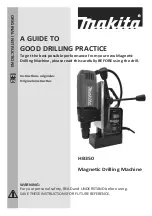
5
6.1 Spindle speeds selection
The correct spindle speed depends on
the type of machining, the cutting
diameter, the material to be machined
and the cutting tool.
These are recommended max. speeds
for a 10mm high speed steel (HSS)
tool (e.g. drill bit).
Aluminium, brass
1500 RPM
Cast iron
1000 RPM
Mild steel
800 RPM
High carbon steel
600 RPM
Stainless steel
300 RPM
If a carbide (HM) tool is used about 5
times higher speeds can be chosen.
Generally speaking, the larger in
relation the cutting diameter, the
smaller the possible RPM.
For example:
Milling mild steel with an end mill of
20mm allows a speed of
400 RPM max.
with HSS tool
2000 RPM max.
with carbide tool
7. Setup and adjustments
Warning:
Setup and adjustment work may
only be carried out after the
machine is protected against
accidental starting.
Push the emergency stop button
and disconnect from the power
source!
7.1 Changing spindle speeds
Speeds may only be changed at
complete spindle standstill.
WARNING:
Changing speeds during spindle or
motor rotation will damage the
gears and switch.
Refer to the speed chart whenever
changing speeds.
7.2 Arbour replacement
Remove the draw bar cover (T, Fig 1).
Select the lowest spindle speed to
keep the spindle from turning.
Loosen the drawbar with a wrench.
Loosen the drawbar 2 to max 3 full
turns.
Tap the drawbar head with a rubber
mallet to dislodge the tool taper.
7.3 Adjusting the Depth Stop
To drill multiple holes at the same
preset depth, use the depth stop (G).
7.4 Engaging the Fine Feed Wheel
To activate the fine feed hand wheel,
set the power feed selection knob (E)
to “0”-position.
The dial can be set to zero on
demand.
7.5 Engaging the power down feed
Loosen quill lock handle (P).
Adjust the drill depth stop (G).
CAUTION:
Do not let feeding depth exceed
spindle stroke.
Engage down feed by pushing out the
down feed handles (H).
The spindle will feed down
automatically until the drill depth stop
has been reached.
The spindle will return to the top by
spring force.
7.6 Tilting the gearhead
To tilt the head , the 90° index pin ( Z,
Fig 5) must be pulled.
Tighten the nut to pull the tapered pin.
Fig 5
Loosen the 3 head lock nuts
(C, Fig 5)…one is on bottom!
The gearhead can be tilted 90° to the
left and 30° to the right.
7.6 Return Spring Adjustment
The return spring is adjusted at the
factory and should not need further
adjustment. If adjustment is
necessary:
Loosen knob (I, Fig. 6) approximately
6mm.
Do not remove the spring cover (H).
Fig 6
Firmly hold the spring cover (H).
Pull out the cover and rotate until the
pin (J) on the return spring plate
engages the next notch in the coil
spring cover. Turn the cover clockwise
to decrease tension and counter-
clockwise to increase tension.
Tighten knob (I).
8. Maintenance and inspection
General notes:
Maintenance, cleaning and repair
work may only be carried out after
the machine is protected against
accidental starting.
Push the emergency stop button
and disconnect from the power
source!
Clean the machine regularly.
Defective safety devices must be
replaced immediately.
Repair and maintenance work on the
electrical system may only be carried
out by a qualified electrician.
8.1 Annual Lubrication:
- Gearbox:
Change the hydraulic oil
DIN 51517-2 CL ISO VG 68
(e.g. BP Energol HLP68, Castrol Hyspin
AWS 68, Mobil DTE Oil Heavy Medium)
Oil must be up to indicator mark in oil
sight glass.
Fill oil by removing oil filler plug..
Drain oil
after first month of
operation
by tilting the head 90° to
the left and by removing drain plug.
Drain entire oil.
Turn head upright and refill with oil.








































